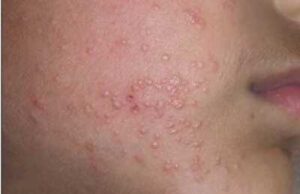
Molluscum contagiosum is a viral skin infection causing raised bumps. Learn about symptoms, transmission, treatment options, and how to prevent its spread effectively.
Introduction
Molluscum contagiosum, a common skin infection, is often misunderstood due to its benign nature and mild symptoms. Despite this, it poses challenges for those infected, especially in how the virus spreads and how long it can linger. As awareness grows, more individuals seek detailed information about this condition. This post will delve into all aspects of molluscum contagiosum, from what it is, how it spreads, treatment options, and, most importantly, ways to prevent it. Understanding the condition will help manage and reduce the social stigma associated with the virus, particularly among children and sexually active adults.
What is Molluscum Contagiosum?
Molluscum contagiosum is caused by a virus known as the molluscum contagiosum virus (MCV), which is part of the poxvirus family. This virus specifically affects the skin, leading to small, raised bumps or lesions. These bumps are usually flesh-colored and can appear anywhere on the body, though they are most common on the face, neck, arms, and hands in children, and on the genital area, inner thighs, and lower abdomen in adults. While the lesions themselves are painless, they can become itchy or irritated. In many cases, individuals will notice these bumps spread over time, particularly if they touch, scratch, or shave over the affected area. Although molluscum contagiosum does not generally cause long-term complications, the appearance of the lesions can cause discomfort, both physically and emotionally.
How Does Molluscum Contagiosum Spread?
The molluscum contagiosum virus spreads easily through direct contact with an infected person. This can happen through casual skin-to-skin contact or by sharing personal items like towels, clothing, or gym equipment. It’s important to note that once someone is infected, they can also spread the virus to other parts of their body by touching or scratching the lesions, a process known as autoinoculation. In adults, molluscum contagiosum is often considered a sexually transmitted infection (STI) because the virus can spread through intimate contact, especially in the genital area. However, sexual activity is not the only way to contract the virus. Children, for example, often contract molluscum contagiosum through play or contact with contaminated surfaces.
Symptoms of Molluscum Contagiosum
One of the hallmark symptoms of molluscum contagiosum is the presence of small, round, firm bumps on the skin. These bumps typically have a dimple or indentation in the center, which is a distinguishing feature of the infection. The size of the lesions can range from a pinhead to the size of a pea, and they often appear in clusters. Although the bumps are usually painless, they can become itchy, red, or inflamed, particularly if they are scratched or irritated. The bumps may appear anywhere on the body, but they are most commonly found on the face, neck, arms, and hands in children. In adults, they are often located in the genital area, on the inner thighs, and the lower abdomen.
The Natural Course of Molluscum Contagiosum
In most cases, molluscum contagiosum resolves on its own without treatment. However, the virus can persist for several months or even up to two years in some individuals. The duration of the infection varies depending on the person’s immune system and how they care for the lesions. For individuals with a healthy immune system, the lesions usually disappear within six to twelve months. However, individuals with weakened immune systems, such as those with HIV/AIDS, may experience more widespread and persistent infections. Although molluscum contagiosum is not dangerous, it can cause discomfort and anxiety, especially if the lesions are in visible areas or if they spread rapidly.
Diagnosing Molluscum Contagiosum
Diagnosing molluscum contagiosum is relatively straightforward. A healthcare provider can usually identify the infection based on the appearance of the characteristic lesions. In most cases, no additional tests are needed. However, in some cases, particularly if the diagnosis is uncertain or if the lesions do not respond to treatment, a biopsy may be performed. During a biopsy, a small sample of tissue is taken from one of the lesions and examined under a microscope to confirm the presence of the molluscum contagiosum virus. It’s important to get an accurate diagnosis, as other skin conditions, such as warts or even skin cancer, can sometimes resemble molluscum contagiosum.

Treating Molluscum Contagiosum: When Is It Necessary?
In many cases, treatment for molluscum contagiosum is not necessary, as the infection often resolves on its own. However, there are certain situations where treatment may be recommended. For example, if the lesions are in a highly visible area, such as the face, or if they are causing discomfort, itching, or irritation, a healthcare provider may suggest treatment. Additionally, treatment may be recommended for individuals with weakened immune systems, as they are more likely to experience severe or prolonged infections. Treatment options for molluscum contagiosum are aimed at removing the lesions and preventing the spread of the virus.
Topical Treatments for Molluscum Contagiosum
One of the most common treatments for molluscum contagiosum is the use of topical medications. These medications are applied directly to the lesions to help remove them and reduce the risk of spreading the virus. Some of the most commonly used topical treatments include salicylic acid, tretinoin, and imiquimod. Salicylic acid works by exfoliating the skin and helping to remove the outer layer of the lesions. Tretinoin, a type of retinoid, helps to speed up skin cell turnover, which can help to clear the lesions more quickly. Imiquimod is an immune response modifier that helps the body fight off the virus.
Cryotherapy: Freezing the Lesions
Cryotherapy is another common treatment for molluscum contagiosum. During this procedure, a healthcare provider uses liquid nitrogen to freeze the lesions, causing them to blister and eventually fall off. Cryotherapy is a quick and effective way to remove the lesions, but it can be uncomfortable, as the freezing process can cause a stinging or burning sensation. Multiple treatments may be necessary to completely remove the lesions, particularly if there are many of them or if they are large. Although cryotherapy is generally safe, it can cause temporary redness, swelling, or scarring at the treatment site.
Curettage: Scraping the Lesions Off
Curettage is a procedure in which a healthcare provider uses a small instrument called a curette to scrape off the lesions. This procedure is often done under local anesthesia to minimize discomfort. Curettage is highly effective at removing the lesions, but it can be more invasive than other treatment options, such as topical medications or cryotherapy. As with cryotherapy, multiple treatments may be necessary to completely remove all of the lesions. Curettage is generally well-tolerated, but it can cause temporary redness, swelling, or scarring at the treatment site.
Laser Therapy for Molluscum Contagiosum
Laser therapy is another treatment option for molluscum contagiosum, particularly for individuals who have not responded to other treatments. During this procedure, a healthcare provider uses a laser to target and destroy the lesions. Laser therapy is a precise and effective way to remove the lesions, but it can be more expensive and time-consuming than other treatments. Additionally, laser therapy may cause temporary redness, swelling, or scarring at the treatment site. Despite these drawbacks, laser therapy can be a good option for individuals with large or stubborn lesions that have not responded to other treatments.
Prevention of Molluscum Contagiosum
Preventing the spread of molluscum contagiosum is important, particularly for individuals who are infected. One of the most effective ways to prevent the spread of the virus is to avoid direct contact with the lesions. This means not touching, scratching, or shaving over the lesions, as this can cause the virus to spread to other parts of the body. It’s also important to avoid sharing personal items, such as towels, clothing, or gym equipment, as these can become contaminated with the virus. Covering the lesions with a bandage or clothing can also help to prevent the spread of the virus.
Molluscum Contagiosum in Children
Molluscum contagiosum is particularly common in children, as they are more likely to come into contact with the virus through play or contact with contaminated surfaces. While the infection is generally harmless, it can cause distress for both the child and their parents, particularly if the lesions are in visible areas or if they spread rapidly. Fortunately, molluscum contagiosum usually resolves on its own in children, and treatment is not always necessary. However, parents should take steps to prevent the spread of the virus, such as encouraging their child not to scratch or touch the lesions and keeping the affected area covered.
Molluscum Contagiosum in Adults
In adults, molluscum contagiosum is often considered a sexually transmitted infection (STI), as it can be spread through intimate contact. However, the virus can also be spread through other means, such as sharing towels or clothing. Adults with molluscum contagiosum should take steps to prevent the spread of the virus, particularly to their sexual partners. Using condoms can help to reduce the risk of transmission, but it’s important to note that the virus can still spread from areas not covered by the condom. As with children, the infection usually resolves on its own in adults, but treatment may be recommended if the lesions are causing discomfort or spreading rapidly.
Complications of Molluscum Contagiosum
Although molluscum contagiosum is generally a mild infection, complications can occur, particularly in individuals with weakened immune systems. In these individuals, the infection can become more widespread and persistent, and the lesions may become larger or more numerous. Additionally, scratching or irritating the lesions can lead to secondary bacterial infections, which may require treatment with antibiotics. In rare cases, molluscum contagiosum can cause scarring, particularly if the lesions are removed through invasive procedures such as curettage or laser therapy. However, for most individuals, the infection resolves without any long-term complications.
When to See a Doctor
Most cases of molluscum contagiosum do not require medical attention, as the infection usually resolves on its own. However, there are certain situations where it may be necessary to see a doctor. For example, if the lesions are in a highly visible area, such as the face, or if they are causing discomfort, itching, or irritation, a healthcare provider can recommend treatment options to help remove the lesions. Additionally, individuals with weakened immune systems or those who are experiencing complications, such as secondary bacterial infections, should seek medical attention. It’s also important to see a doctor if the lesions do not improve with treatment or if they spread rapidly.
Molluscum Contagiosum and Immune System
The immune system plays a key role in determining how long molluscum contagiosum lasts and how severe the infection becomes. Individuals with a healthy immune system are more likely to clear the infection on their own within six to twelve months. However, individuals with weakened immune systems, such as those with HIV/AIDS or individuals undergoing chemotherapy, may experience more severe or prolonged infections. In these cases, treatment may be necessary to help clear the infection and prevent complications. Additionally, boosting the immune system through a healthy diet, regular exercise, and stress management may help to speed up recovery.

The Psychological Impact of Molluscum Contagiosum
Although molluscum contagiosum is generally harmless, the appearance of the lesions can cause significant psychological distress, particularly for individuals with lesions in visible areas. Children, in particular, may feel self-conscious or embarrassed about the bumps, especially if they are teased by their peers. Adults with lesions in the genital area may also experience anxiety or embarrassment, particularly if they are concerned about spreading the virus to their sexual partners. It’s important to remember that molluscum contagiosum is a common and treatable condition, and seeking support from a healthcare provider or counselor can help to alleviate these feelings of distress.
Long-Term Outlook for Molluscum Contagiosum
The long-term outlook for molluscum contagiosum is generally very good, as the infection usually resolves on its own without causing any long-term complications. However, the duration of the infection can vary, and some individuals may experience the infection for several months or even up to two years. In most cases, the lesions will disappear without leaving any scars, although some individuals may experience temporary redness or discoloration at the site of the lesions. With proper care and treatment, most individuals can expect to fully recover from molluscum contagiosum and return to their normal activities without any lasting effects.
Conclusion
Molluscum contagiosum is a common and generally harmless skin infection that can affect both children and adults. While the infection often resolves on its own, treatment may be necessary in some cases to remove the lesions and prevent the spread of the virus. By understanding how the virus spreads, recognizing the symptoms, and exploring treatment options, individuals can effectively manage molluscum contagiosum and reduce the risk of complications. Taking steps to prevent the spread of the virus, such as avoiding direct contact with the lesions and not sharing personal items, is key to managing the infection and preventing its spread to others.





